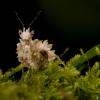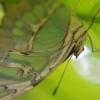Earlier in the summer, I posted an identification thread for six Pheidole queens I caught in South Eastern PA. Once of them has passed and one isn't developing very quickly, but the other four are doing quite well. Three of the successful ones are most definitely Pheidole bicarinata, and have 20-30 workers each. The fourth is very light in coloration, and her workers are a bright yellowish orange.
The colony I'm trying to identify was the sixth in the original post. Information regarding this queen is available in the original thread, but I'll reiterate some.
I think this colony is Pheidole tysoni, although I would like a second opinion. For reference, the only recorded Pheidloe species in Pennsylvania are Ph. bicarinata and Ph. pilifera, but Ph. davisi, Ph. morrisii, Ph. dentata and Ph. tysoni have been recored in states adjacent to Pennsylvania.
1. Location (on a map) of collection: Philadelphia, Pennsylvania
2. Date of collection: June 21, on sidewalk at approximately 11:00 AM.
3. Habitat of collection: Field/deciduous forest. Mostly clay soil.
4. Length (from head to gaster): ~5-5.5 mm (Q), ~2.0-2.4 mm (M), ~1.3-1.7 mm (m)
5. Color, hue, pattern and texture: Queen: Light orange with single black dot underneath the center of her gaster. Workers: transulcent orange to light yellow, with dark spots on gaster. Nanitics were more yellow and later generations seem to be more orange.
6. Distinguishing characteristics: Ocelli on queen 6 are darker than rest of body.
We noticed how light these workers were, and made an outworld with black sand, to contrast the workers' bright colorations.



























